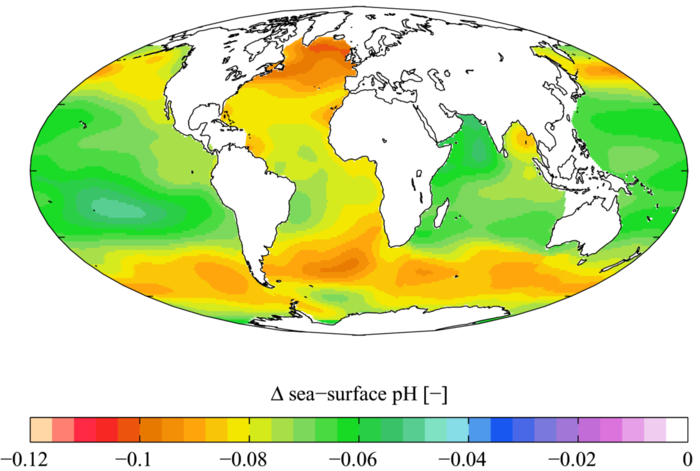Ocean acidification: Difference between revisions
No edit summary |
m (1 revision imported) |
(No difference)
| |
Revision as of 04:31, 18 February 2016
Ocean acidification is a major climate change problem, concerning the change in acidic levels of the ocean. It is a consequence of the emissions of certain greenhouse gases, particularly carbon dioxide.
Acidification occurs when the pH in a given system decreases. In this case, the pH change is caused by an increased intake of carbon dioxide. As carbon dioxide and other compounds of carbon are emitted into the atmosphere by human activities (such as from motor vehicle emissions or coal-fired power plants), there becomes a net increase of carbon in the atmosphere, with around 30% of anthropogenic CO2 making its way into the oceans.[1]
Carbon dioxide and water react together to form carbonic acid, and this is what is causing increased acid levels in the oceans. The chemical reaction is:[1]

How the ocean takes in carbon
The ocean and atmosphere are coupled with one another, causing an exchange of matter between the two. Since the ocean is a tremendous carbon pool that makes use of pressure differences between its gas contents and that of the atmosphere, particles are exchanged through this pressure difference until equilibrium is reached between the two systems. As carbon dioxide levels increase in the atmosphere, as they have been, the ocean and atmosphere must reach a new equilibrium. Through this, the ocean acts as a carbon sink, which has increased carbon dioxide levels in the ocean's surface layers.[3]
Measurements over recent years have indicated an increase of carbon dioxide in the surface layers of the oceans by 1.6-1.9 ppm per year, which is in accordance with the atmospheric increase of 1.5-1.9 ppm/year.[3] For a slightly more technical analysis, see Reference 1.
Although the ocean takes out carbon from the atmosphere that would otherwise contribute to global warming, there are adverse effects because of this. The average pH of the ocean has already decreased by around 0.1 since the industrial era (decrease in pH means more acidity), and since the pH scale is logarithmic, this means the ocean is 30% more acidic than it was prior to this period.[4] This affects many organisms in negative ways, as will be explored next.
Effects of Acidification
Many biological species are expected to be negatively affected by an increase in acidic levels. Studies have shown that a more acidic environment has a dramatic effect on some calcifying species, including oysters, clams, sea urchins, shallow water corals, deep sea corals, and calcareous plankton.[4] Acidification has also shown to significantly reduce the ability of reef-building corals to produce their skeletons, and some research shows that, by the end of the century, coral reefs may erode faster than they can rebuild.[4]
Over a billion people around the world get their main source of protein from the ocean, and hundreds of thousands of jobs are reliant on the well-being of ocean species. Therefore from a human wellness standpoint alone, the acidification of the oceans is a major problem.
The video below by World Bank discusses ocean acidification in more detail, and why it is a problem.
References
- ↑ 1.0 1.1 IPCC. (Accessed December 31, 2015). Frequently Asked Questions, FAQ 3.3, page 15 of report, Available: http://www.climatechange2013.org/images/report/WG1AR5_FAQbrochure_FINAL.pdf#25
- ↑ Wikimedia Commons [Online], Available: https://commons.wikimedia.org/wiki/File:WOA05_GLODAP_del_pH_AYool.png#/media/File:WOA05_GLODAP_del_pH_AYool.png
- ↑ 3.0 3.1 M. Melieres and C. Marechal, "Recent Climate Change," in Climate Change: Past, Present and Future 1st ed., U.K.: Wiley, 2015, ch.25.1.3, pp. 248-249
- ↑ 4.0 4.1 4.2 NOAA. (Accessed December 31, 2015). What is Ocean Acidification [Online], Available: http://www.pmel.noaa.gov/co2/story/What+is+Ocean+Acidification%3F

